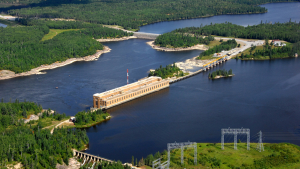Ehab El-Salakawy, a professor of structural engineering at the University of Manitoba, has won the American Concrete Institute’s 2020 Mete A. Sozen Award for Excellence in Structural Research.
The award recognizes a notable achievement in experimental or analytical research that advances the theory or practice of structural engineering and recommends how the research can be applied to design.
The paper bears a title that most non-engineers will find formidable: Lateral Displacement Deformability of GFRP-RC [glass-fiber-reinforced-polymer reinforced-concrete] Slab-Column Edge Connections.
It contains a lengthy report of the method and results of an experiment that measured how much GFRP reinforcement will lengthen under tension stress, which takes place during an earthquake or other seismic event, before the material fails.
The experiment compared the responsiveness of concrete slab-column connections reinforced with, respectively, GFRP reinforcement and steel reinforcement, in a simulated seismic event.
The simulation showed the GFRP-RC edge connections were able to withstand the seismic stresses and at the same time maintain their load-carrying capacity.
GFRP is a new type of fibre-reinforced polymer (FRP).
El-Salakawy says the latter has been in use for only a relatively short time – since early in the 21st century – as reinforcement for concrete structures.
“The main feature of FRP reinforcement is its non-corrosive nature,” he said. “Because it doesn’t contain steel, there’s no corrosion, which is a major cause of deterioration in such structures and cannot be stopped.”
Because the mitigation and repair of corroded steel-reinforced concrete can be expensive, eliminating the corrodible part of the structural element increases its service life and reduces life-cycle costs.
El-Salakawy says FRP reinforcement has other properties that make it attractive to the construction industry.
They include greater strength (four to five time that of regular steel); lighter weight (one-quarter to one-third that of steel), which means lower transportation and installation costs; and electrical inertia (changes in electrical current are neutralized), which is required for such applications as magnetic resonance imaging (MRI) rooms and toll-free roads.
In addition, FRP-reinforced concrete requires much less maintenance than steel-reinforced concrete, says El-Salakawy.
“Maintenance for such things as concrete deterioration, joint leakage and accidents are minor compared to steel corrosion, especially in harsh climates, like Canada’s,” he said.
On the other hand, FRP has some negative mechanical properties, such as brittle failure (sudden failure without warning) and relatively lower stiffness compared to steel.
“This can result in softer and non-ductile structures,” said El-Salakawy. “Ductility is required in buildings to provide enough warning of potential failure so that tenants or building owners can act – by repairing or evacuating – before the building fails.”
El-Salakawy says his research on FRP and GFRP-RC structures is “a pioneer” in addressing seismic design that requires ductility of reinforcement.
He has undertaken advanced research on a range of full-scale structural components, including beam-column joints, slab-column connections and beam-slab-column assemblies, and column-footing connections (to simulate high-rise buildings and bridges in seismic zones).
El-Salakawy says the significance of his research to engineers and the construction industry is that it opens the application of FRP reinforcement to many different kinds of reinforced concrete structures.
He hopes it will enable the building of completely corrosion-free structures in any location, including seismic zones.
“But as it stands now, even though the use of FRP reinforcement has been increasing, it has limited applications to just a few structural elements, such as bridge deck slabs, bridge barriers and simple beams/bridge girders,” said El-Salakawy.
Upcoming changes in design codes around the world (especially in Canada and the US) will incorporate the results of research in FRP reinforcement by El-Salakawy and other investigators and will cover most structures.
“The main focus of these new codes – and my work – is on the use of GFRP reinforcement, as it is much cheaper and has more deformation capacity [how much it will lengthen under tension stress until it fails] than other types of FRP reinforcement, which make it attractive to designers and infrastructure owners,” said El-Salakawy.
Looking ahead, FRP-reinforced concrete is expected to be used on all kinds of concrete structures.
“At the moment it is used mostly in bridge superstructure elements – deck slabs and barriers – and is used very little in buildings,” he said.
El-Salakawy hopes FRP-reinforced concrete eventually replace steel-reinforced concrete.
“It will take time, but we are moving in that direction, thanks to the very good research results we have been obtaining and the steadily decreasing cost of manufacturing GFRP reinforcement,” he said.











Recent Comments